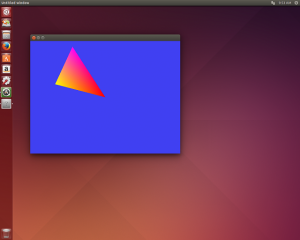검색해서 발견한 것인데 표준 path의 위치에 libEGL과 libGLESv2들의 공유 object가 없어서 아래와 같이 symbolic link로 연결해 보았습니다.
cd /usr/lib/arm-linux-gnueabihfsudo ln -s tegra-egl/libEGL.so.1 libEGL.sosudo ln -s tegra-egl/libGLESv2.so.2 libGLESv2.so표준적으로는 EGL과 GLES2의 header가 없기때문에, Khronos OpenGL ES Registry(http://www.khronos.org/registry/gles/ )로부터 다운로드 합니다. 다운로드 한 파일들은 바로 프로그램과 같은 장소에 디렉토리 구성이 있는 것처럼 배치했습니다.사용한 프로그램은 이렇습니다.
#include <stdio.h>#include <stdlib.h>#include <math.h>#include <string.h>#include <X11/Xlib.h>#include <X11/Xutil.h>#include <X11/Xatom.h>#include "EGL/egl.h"#include "GLES2/gl2.h"#include <sys/time.h>static Display* xdisp;static Window window;EGLDisplay eglDisplay;EGLContext eglContext;EGLSurface eglSurface;static GLuint shaderProgram;void initializeEGL();void terminateEGL();void mainloop();GLuint createShaderProgram();int main() {xdisp = XOpenDisplay( NULL );if( xdisp == NULL ) { return -1; }Window rootWin = DefaultRootWindow( xdisp );int screen = DefaultScreen( xdisp );unsigned long white = WhitePixel( xdisp, screen );unsigned long black = BlackPixel( xdisp, screen );window = XCreateSimpleWindow( xdisp, rootWin, 100, 100, 640, 480, 2, black, white );XSelectInput( xdisp, window, KeyPressMask|ButtonPressMask|UnmapNotify );Atom atom, atom2;atom = XInternAtom( xdisp, "WM_DELETE_WINDOW", False );XSetWMProtocols( xdisp, window, &atom, 1 );atom2 = XInternAtom( xdisp, "WM_PROTOCOLS", False );XMapWindow( xdisp, window );XFlush( xdisp );initializeEGL();shaderProgram = createShaderProgram();XEvent evt;bool isFinish = false;int frameCount = 0;timeval t0, t1;gettimeofday( &t0, NULL );const int countSecond = 5;do {while( XPending( xdisp ) ) {XNextEvent( xdisp, &evt );switch( evt.type ) {case ClientMessage:if( evt.xclient.message_type == atom2 && evt.xclient.data.l[0] == atom ) {XFlush( xdisp );isFinish = true;}break;case KeyPress:isFinish = true;break;}}mainloop();frameCount++;gettimeofday( &t1, NULL );if( t1.tv_sec * 1000000 + t1.tv_usec - t0.tv_sec * 1000000 - t0.tv_usec > countSecond * 1000000 ) {printf( "FPS: %.2f\n", frameCount / (float)countSecond );gettimeofday( &t0, NULL );frameCount = 0;}} while( !isFinish );glDeleteProgram( shaderProgram );terminateEGL();XDestroyWindow( xdisp, window );XCloseDisplay( xdisp );return 0;}void initializeEGL() {eglDisplay = eglGetDisplay( (EGLNativeDisplayType) xdisp );if( eglDisplay == EGL_NO_DISPLAY ) {fprintf( stderr, "NO EGL DISPLAY\n" );return;}if( !eglInitialize( eglDisplay, NULL, NULL ) ) {fprintf( stderr, "Unable to initialize EGL\n" );return;}EGLint attr[] = {EGL_RED_SIZE, 8, EGL_GREEN_SIZE, 8, EGL_BLUE_SIZE, 8, EGL_ALPHA_SIZE, 8,EGL_SURFACE_TYPE, EGL_WINDOW_BIT, EGL_RENDERABLE_TYPE, EGL_OPENGL_ES2_BIT, EGL_NONE,};EGLConfig cfg;EGLint numConfigs = 0;if( !eglChooseConfig( eglDisplay, attr, &cfg, 1, &numConfigs )) {fprintf( stderr, "Failed to choose config.\n" );return;}eglSurface =eglCreateWindowSurface( eglDisplay, cfg, window, NULL );if( eglSurface == EGL_NO_SURFACE ) {return;}EGLint ctxAttr[] = {EGL_CONTEXT_CLIENT_VERSION, 2, EGL_NONE,};eglContext = eglCreateContext( eglDisplay, cfg, EGL_NO_CONTEXT, ctxAttr );if( eglContext == EGL_NO_CONTEXT ) {fprintf( stderr, "Unable to create EGL context. (%d).\n", eglGetError() );return;}eglMakeCurrent( eglDisplay, eglSurface, eglSurface, eglContext );printf( "GL_RENDERER: %s\n", (char*)glGetString( GL_RENDERER ) ); printf( "GL_VENDOR: %s\n", (char*)glGetString( GL_VENDOR ) );printf( "GL_VERSION: %s\n", (char*)glGetString( GL_VERSION ) );printf( "EGL_VENDOR : %s\n", eglQueryString( eglDisplay, EGL_VENDOR ) );printf( "EGL_VERSION: %s\n", eglQueryString( eglDisplay, EGL_VERSION ) );printf( "EGL_CLIENT_APIS : %s\n", eglQueryString( eglDisplay, EGL_CLIENT_APIS ) );eglSwapInterval( eglDisplay, 0 );}void terminateEGL() {eglDestroyContext( eglDisplay, eglContext );eglDestroySurface( eglDisplay, eglSurface );eglTerminate( eglDisplay );}static GLchar srcVertexShader[] ="attribute vec4 position0;\n""attribute vec4 color0;\n""varying vec4 vsout_color0;\n""uniform float theta;\n""void main() {\n"" gl_Position = position0;\n"" gl_Position.x = position0.x * cos(theta) - position0.y * sin(theta);\n"" gl_Position.y = position0.x * sin(theta) + position0.y * cos(theta);\n"" vsout_color0 = color0;\n""}";static GLchar srcFragmentShader[] ="precision mediump float;\n""varying vec4 vsout_color0;\n""void main() {\n"" gl_FragColor = vsout_color0;\n""}";void checkCompiled( GLuint shader ) {GLint status;glGetShaderiv( shader, GL_COMPILE_STATUS, &status );if( status != GL_TRUE ) {GLint length;glGetShaderiv( shader, GL_INFO_LOG_LENGTH, &length );if( length ) {char* buf = (char*)malloc( length );glGetShaderInfoLog( shader, length, NULL, buf );fprintf( stderr, "CompiledLog: %s\n", buf );free( buf );}exit( EXIT_FAILURE );}}GLuint createShaderProgram() {GLuint shaderVS = glCreateShader( GL_VERTEX_SHADER );GLuint shaderFS = glCreateShader( GL_FRAGMENT_SHADER );GLsizei length;GLchar* vsSources[] = {srcVertexShader,};GLchar* fsSources[] = {srcFragmentShader,};glShaderSource( shaderVS, 1, (GLchar**) &vsSources, NULL );glCompileShader( shaderVS );checkCompiled( shaderVS );glShaderSource( shaderFS, 1, (GLchar**) &fsSources, NULL );glCompileShader( shaderFS );checkCompiled( shaderFS );GLuint program;program = glCreateProgram();glAttachShader( program, shaderVS );glAttachShader( program, shaderFS );glLinkProgram( program );return program;}void mainloop() {static unsigned int count = 0;float v = sinf( count * 0.001f ) + 1;v *= 0.5f;glClearColor( 0.25f, 0.25f, v, 0.0f );glClear( GL_COLOR_BUFFER_BIT | GL_DEPTH_BUFFER_BIT );glUseProgram( shaderProgram );GLint locPos = glGetAttribLocation( shaderProgram, "position0" );GLint locColor = glGetAttribLocation( shaderProgram, "color0" );float vertices[] = {0.0f, 0.0f, 0.0f, 1.0f, 0.0f, 0.0f, 1.0f,1.0f, 0.0f, 0.0f, 1.0f, 0.0f, 1.0f, 1.0f,0.5f, 0.5f, 0.0f, 1.0f, 1.0f, 0.0f, 1.0f,};GLint stride = sizeof(float)*7;glVertexAttribPointer( locPos, 3, GL_FLOAT, false, stride, &vertices[0] );glVertexAttribPointer( locColor, 4, GL_FLOAT, false, stride, &vertices[3] );glEnableVertexAttribArray( locPos );glEnableVertexAttribArray( locColor );glUniform1f( glGetUniformLocation( shaderProgram, "theta" ), count*0.001f );glDrawArrays( GL_TRIANGLES, 0, 3 );eglSwapBuffers( eglDisplay, eglSurface );count++;}이 프로그램을 실행하면 다음과 같이 됩니다.

GL_RENDERER: GK20A/AXIGL_VENDOR: NVIDIA CorporationGL_VERSION: OpenGL ES 3.0 19.3EGL_VENDOR : NVIDIAEGL_VERSION: 1.4EGL_CLIENT_APIS : OpenGL_ES OpenGLFPS: 262.60FPS: 177.60FPS: 155.40FPS: 167.00FPS: 169.40FPS: 257.00FPS: 269.20FPS: 177.00
이 버전에서는 이미 OpenGL ES 3.0의 Context로 되어 있는 것 같습니다.GLESv2의 라이브러리를 link해서, 프로그램 중에는 ES 2.0을 지정할 예정이었지만, 좀 이상한 상태입니다.
Congratulations @kimhoe! You received a personal award!
You can view your badges on your Steem Board and compare to others on the Steem Ranking
Do not miss the last post from @steemitboard:
Vote for @Steemitboard as a witness to get one more award and increased upvotes!
Downvoting a post can decrease pending rewards and make it less visible. Common reasons:
Submit
Downvoting a post can decrease pending rewards and make it less visible. Common reasons:
Submit
Downvoting a post can decrease pending rewards and make it less visible. Common reasons:
Submit